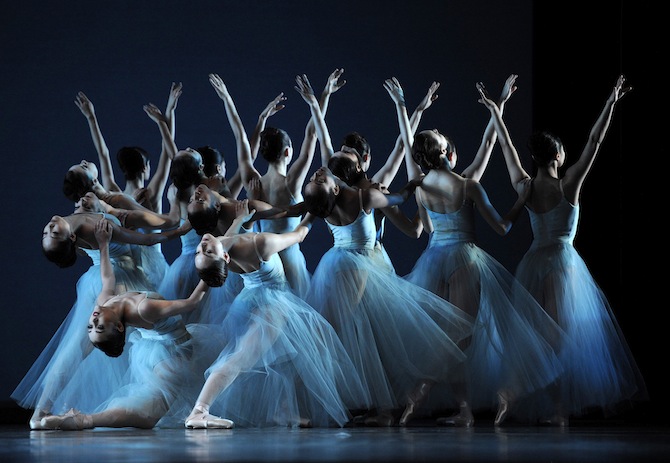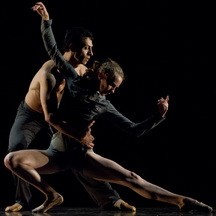
From neoclassical Balanchine …
San Francisco Ballet opened its 2014 season with a diverse cluster of ballets aimed to satisfy. The three ballets covered a range of contemporary ballet – the premieres of the three ballets took place in 1934, 1995 and 2011. But even more startling was the range of musical settings and tonal quality. Imagine coupling Bach and traditional African songs … as choreographer Val Caniparoli did in the evening’s closing piece, Lambarena. The company reveled in the challenge, unleashing their formidable technique and expressive élan.
The evening opened with Balanchine’s Serenade. And what better choice for a company that exalts that choreographer’s work, so much so that at one time it might have been called New York City Ballet West? Even though the company has matured into its own style and repertoire, it remains one of the best interpreters of Balanchine.
And Serenade is quintessential Balanchine. With its 17 ballerinas in long, ethereal tutus, it’s an homage to girl power, which nonetheless suggests its own self-awareness in the occasional quirky movement. Even the opening pose of rows of dancers standing motionless, only a single arm raised, the wrist line broken, palm of the hand skyward as if saluting and fending off the sun in the same careful gesture, pulls away from the clichés of Romantic ballet and hints at a small satiric smile.
The sweet melancholy of Tchaikovsky’s Serenade in C Major sets the tone for this ballet of long arms and legs around which float yards of baby-blue tulle. Its yearning is reminiscent of other classical ballets in which the corps de ballet provides a distantly erotic setting of lost love: Swan Lake, Les Sylphides, Giselle. But although representing inaccessible love is the function of the corps de ballet in these classic ballets, that is not its role in this ballet in which the corps becomes the primary soloist. Rather, its role follows the trajectory of divine excess: if one beauty is amazing, two beauties are fabulous, and three beauties (and more) are mind-bogglingly mythic. Such that the flow of beauty overpowers the choreography’s move from lucid order through chaos and back to perfect symmetry.
Soloists ripple through the flow and ebb of the dancers; the Romantic male appears, disappears and reappears, tripled at the ballet’s finale to provide a moving pedestal for a single ballerina; the group processing through a line of dancers, followed by the ballerina’s acolyte. All women become one woman and one woman becomes all women: exquisite, sexual, iconic, moving away from us always, her back turned.
… to Possokhov’s RaKU …
Speaking of beauty, the second piece on the program, Yuri Possokhov’s RaKU, is also an homage to the power of feminine beauty. Not only as a piece of choreography but also as a showcase for principal dancer, Yuan Yuan Tan.
The piece is publicized as being based on the 1950 burning of the reliquary, or Golden Pavillion, of Kinkaku-ji in Kyoto. But it bears only the slimmest connection to the event or to Yukio Mishima’s 1956 novel. Gary Wang’s libretto makes the violation of a beautiful woman by an obsessed monk the centerpiece of the story; the burning of the reliquary seems secondary. That despite the wonderful video projection design by Alexander V. Nichols. True, the man who destroyed the reliquary was a monk, a schizophrenic obsessed with beauty. But the beauty was that of the temple.
Even so, what beauty Yuan Yuan embodies! With her elegant legs and feet, and extraordinary flexibility. Tan’s back and stomach muscles, like the legendary turtles, could carry the planet across time and space. One can certainly forgive Wang and Possokhov’s desire to put her front and center. Her delicacy shimmers and turns transcendant, placed, as it is, among all male dancers – her husband (Carlos Quenedit), his retainers (Gaetano Amico, Steven Morse, Sean Orza and Myles Thatcher) and the mad monk (Pascal Molat). All the men’s choreography was ultra-manly – lots of flexing and stamping. And Molat added an acrobatic vigor to the part.
… to Caniparoli’s Lambarena
Lambarena closed out the program, mixing rather fitfully, the music of Bach with African rhythms and song. Brightly costumed by Sandra Woodall, the vivid choreography by former SF Ballet Choreographer in Residence’s Val Caniparoli proved that ballerinas can do anything in pointe shoes, including shaking their booties. Led by Lorena Feijoo, the cast flung hips, circled torsos and shook shoulders. Soloist Daniel Deivison-Oliveira put in a terrifically sexy performance.
The Bach sections – for the most part, these were musically separate from the African singing and rhythms and comprised their own sections – seemed less vibrant, moving, as the choreography did, back into more classical balletic steps. And there’s something odd about watching ballet danced to Bach with the male dancers in T-shirts and brightly patterned beachcomber trousers.
Nonetheless, it was a fun, up-beat and vigorous performance. And a great way to start the season.
– Jaime Robles
SF Ballet’s Program 1 continues through February 7 at the War Memorial Opera House in San Francisco. For tickets and information, visit sfballet.org.
Photo: San Francisco Ballet in Balanchine’s Serenade. Photo by Erik Tomasson.
